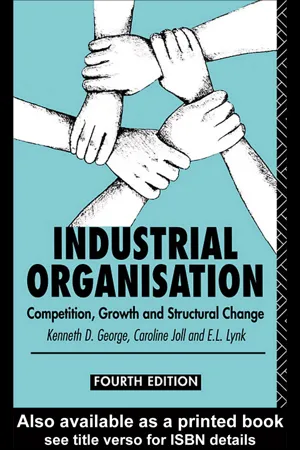Economics
Price Leadership
Price leadership occurs when a dominant firm in an industry sets the price for its products or services, and other firms in the market follow suit. This strategy is often seen in oligopolistic markets, where a few large firms have significant market power. Price leadership can help maintain stability in prices and reduce price competition among firms.
Written by Perlego with AI-assistance
Related key terms
3 Key excerpts on "Price Leadership"
- eBook - ePub
- A. Marijs, W. Hulleman(Authors)
- 2019(Publication Date)
- Routledge(Publisher)
In the first place, they can fix their prices at the level of their competitors. This means that they can create a higher profit margin than their competitors. However, this creates the threat of new entrants. Potential entrants will be attracted by the high profit margins and will try to corner a piece of the market for themselves. The business conduct of these entrepreneurs will cause the market structure to become less tightly amalgamated. Loss of market share and the decrease in market prices will force the producer concerned to keep on lowering his costs. In order to increase their share of the market, companies that have adopted a cost leadership strategy could also lower their price to below that of their competitors. This type of price setting is termed limit pricing. A company with a market share of between 40% and 100% can attain a Price Leadership position comfortably. The other companies in the industry will adjust their prices to those of such a com pany. If a lowest cost strategy with on-going price decreases to below the level of the competitors is successful, the competitors will in the end be forced to leave the industry and the industry will become a monopoly.Profit erosionPrice rigidityDespite the advantages of limit pricing it is not always a good thing. With an inelastic demand, decreases in price will lead to decreased returns despite increased sales. This could affect profits in the entire industry. Such a situation is described as profit erosion by price cutting. Such a business practice is obviously not suitable for every market. Companies on oligopolistic markets will often elect to adopt a certain price rigidity which gives the industry some degree of stability. This is all the more important if entrepreneurs are not certain about the cost levels of their competitors. Table 3.5 summarises the lowest cost strategy.Test 3.5A manufacturer of metal products is experiencing a lot of competition from the eastern European countries. The company is considering a cost leadership strategy. How wise is this in your opinion?In general, companies that follow a cost strategy correspond to the identifying features in the left-hand column of Table 3.2 .Table 3.5 The lowest cost strategyCosts leadership in combination with Consequences Prices at or above the level of competitors High profit margin for the cost leaderPossibly more competitors (deconcentration) Prices below the level of competitors Large share of the market and high profits for the cost leaderCompetitors leave the market (concentration)Profit erosion in the industry through price cutting Investments
Investing is one way that companies can lower their costs. Companies that invest a lot are able to keep on increasing their productivity since they are able to introduce the newest techniques that supplying firms have developed. - eBook - ePub
- Paul Reynolds, Geoff Lancaster(Authors)
- 2005(Publication Date)
- Routledge(Publisher)
Maintenance of market share is at least a key to survival, and price carries much of the burden of responsibility in a marketing mix designed to maintain or improve market share. In terms of measuring success, it is not difficult to establish the size of the market, and estimate respective market shares.7.3.3 Maintaining Price Stability
A pricing policy with the objective of maintaining price stability and margins might seem to detract from marketing creativity and free choice. Although it is true that some products can be promoted and priced as prestige items, most firms have little influence over the general level of prices in a market. They must organise their businesses so that costs are at a level that will permit them to fall in line with the prices charged by market leaders. Prices tend, therefore, to be ‘market led’ with little scope for deviation from established price structures.Provided a company’s returns are considered adequate, there is considerable justification for maintaining the status quo by meeting competitive prices established by the market leaders. The market or price leaders do not stand to gain very much by distancing their prices too much (either upwards or downwards) from smaller competitors. Price adjustments are usually only made in response to changing market conditions.Certain conditions may require an aggressive approach to pricing. During the introduction and growth stages of the product life cycle, price usually plays a less significant role. During maturity and growth (where most products are situated) the major ‘price wars’ are usually fought. Whilst changes in market share can be achieved by price-cutting, as a general rule, this is to be avoided as it works to the detriment of everyone.The idea of a ‘price leader’ does not imply a monopolistic situation, or that one company is exploiting the market because of its position of power. The position of leadership is not absolute; it can be threatened and will certainly be attacked by competitors if the power is abused. Finally, it should be noted that Price Leadership does not equate to absolute authority. Many price leaders are not the principal market shareholders, although they will be major participants. Price Leadership does not render a firm impervious to competitors who engage in non-price competition. Companies can improve their market share by shrewd use of the marketing mix, whilst at the same time pursuing a price stability objective. The party with the ultimate influence in price setting is usually customers, although they have less influence in some markets than others. For example, the market for petrol is one where the consumer has no real choice of substitutes and consequently little influence on price. - eBook - ePub
Industrial Organization
Competition, Growth and Structural Change
- Kenneth George, Caroline Joll, E L Lynk(Authors)
- 2005(Publication Date)
- Routledge(Publisher)
Chapter 6 Dominant firms 6.1 INTRODUCTION In economic theory monopoly is a term used to describe a market in which there is only one seller of a good or service. This is obviously a case of dominance. The concept of dominance also extends to all those cases where one firm has a large share of the market. However, it is not possible to define precisely how large this share has to be. Dominance clearly exists when the leading firm has 80 per cent of the market, but what if it has 50 per cent? Much then depends on the size of the next largest firm. If the nearest rival has, say, 10 per cent of the market, most would agree that a measure of dominance exists, but if there are only two other firms with shares of 30 per cent and 20 per cent the position is less clear. Dominance is thus viewed as a structural concept, and though it is not precisely defined it is a concept nevertheless which is recognised as important both in the theoretical literature and in policy matters. Geroski and Jacquemin (1984) have, however, suggested an alternative approach. They argue that dominance should be defined in terms of the ability to exploit a strategic advantage at the expense of rivals, and that a high market share is one of the likely consequences of strategic behaviour. The suggestion is not very helpful. The authors themselves admit that strategic advantages are extremely difficult to measure even ex post, so that one is driven to infer the existence of a strategic advantage by one of its most likely consequences—the emergence and persistence of high market shares. So for policy purposes the starting point must be structural. Furthermore, many firms with relatively little market power will be able to make use of some strategic advantages over existing rivals and potential entrants. Nor is it the case that strategic behaviour explains all positions of high market share
Index pages curate the most relevant extracts from our library of academic textbooks. They’ve been created using an in-house natural language model (NLM), each adding context and meaning to key research topics.


